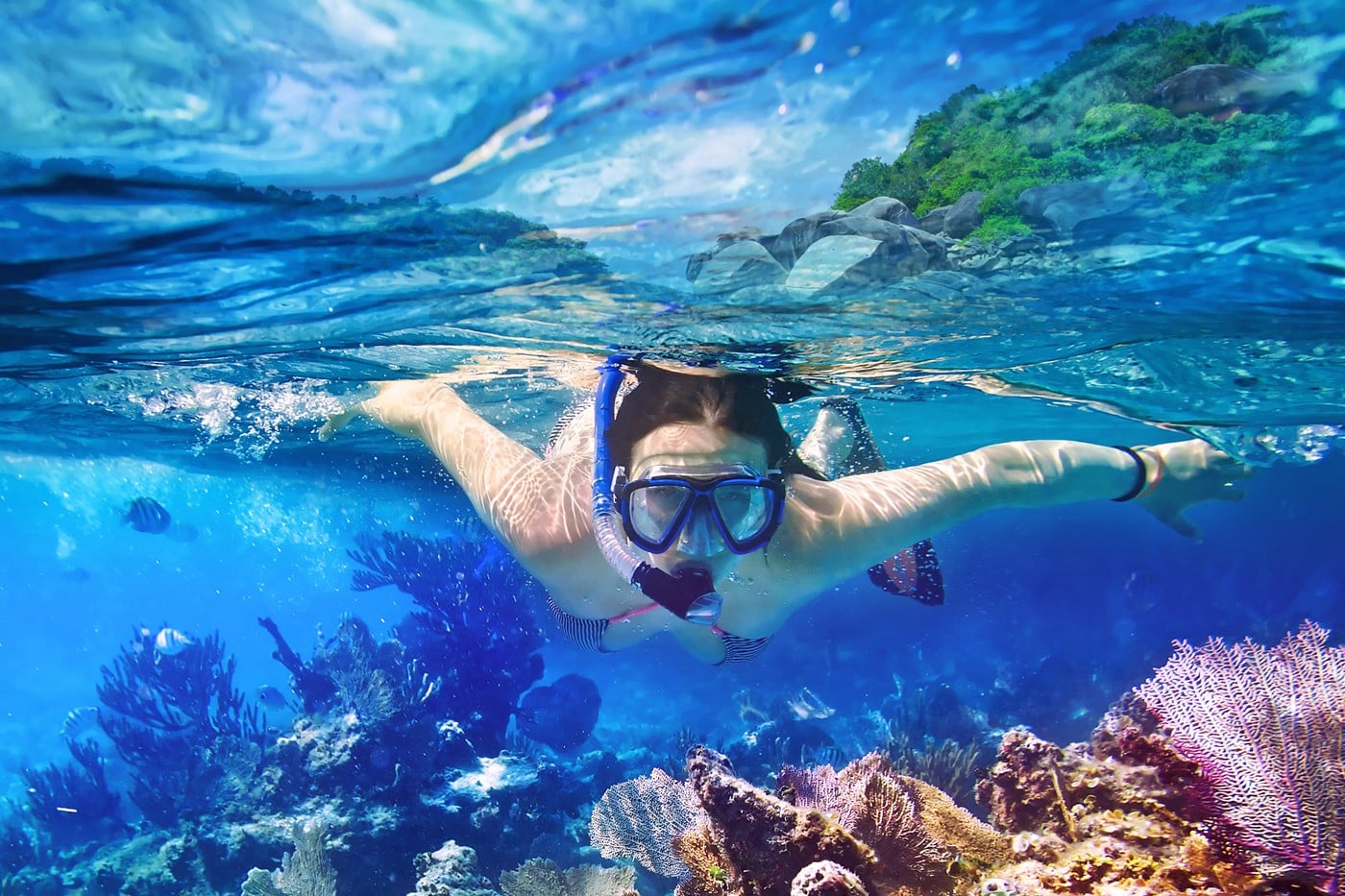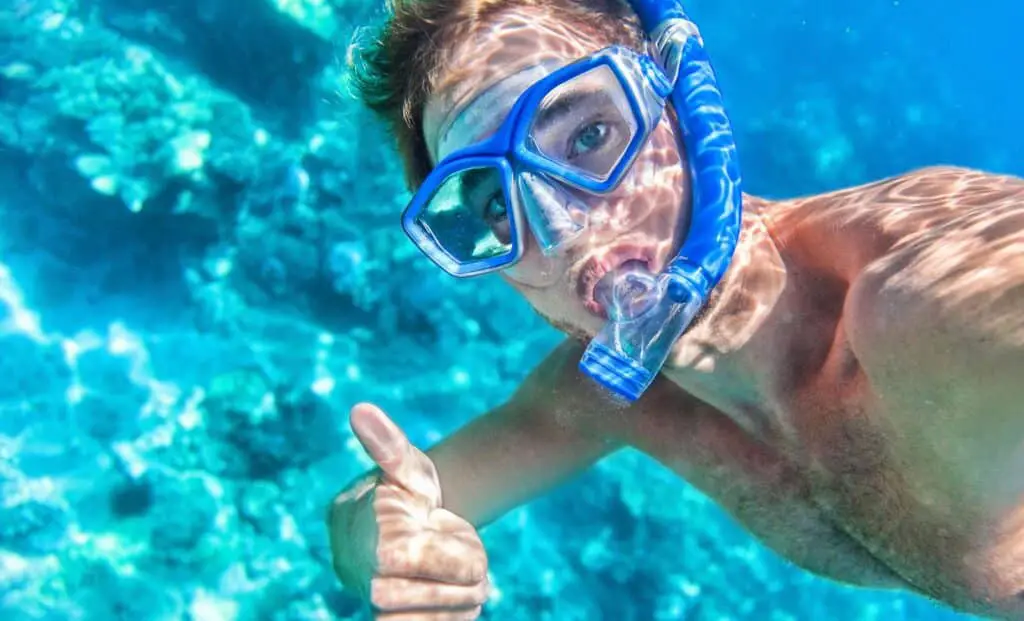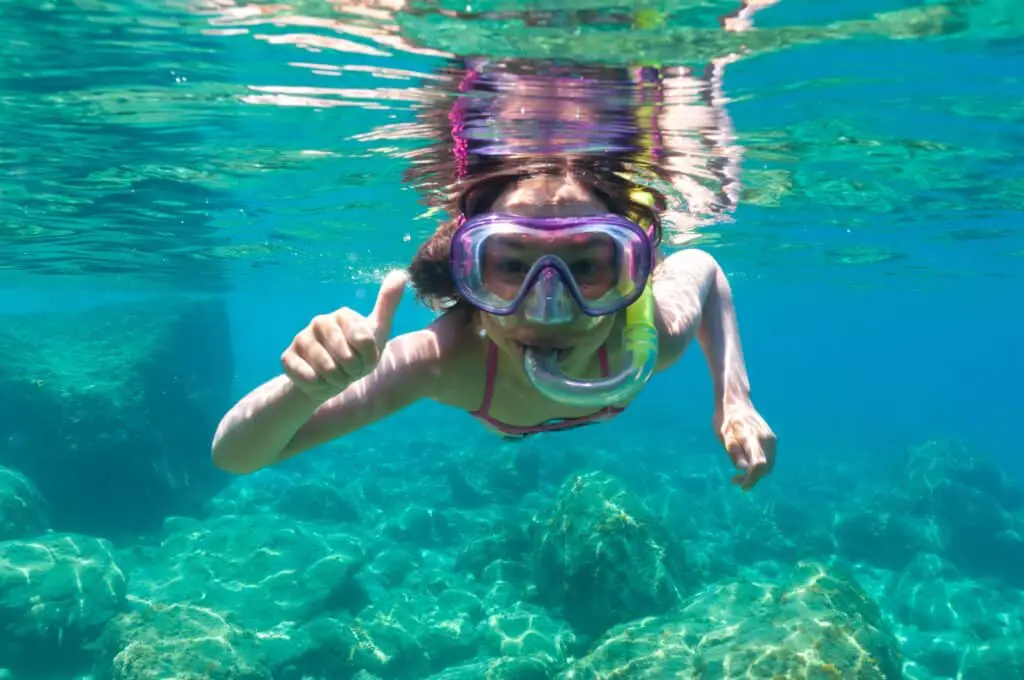How To Snorkel Without Swallowing Water

Introduction
How To Snorkel Without Swallowing Water: Snorkeling is a mesmerizing way to explore the beauty of the underwater world, offering a glimpse into the vibrant and mysterious marine life that lies beneath the surface. However, for many beginners, one common challenge stands in the way of this aquatic adventure: swallowing water. The discomfort and frustration of accidentally inhaling seawater can quickly turn an exciting snorkeling excursion into a less enjoyable experience.
But fear not, for this guide is here to equip you with the knowledge and techniques needed to snorkel without swallowing water. Whether you’re a novice looking to embark on your first snorkeling adventure or an experienced snorkeler seeking to improve your skills, this comprehensive guide will provide you with invaluable insights and practical tips to ensure that every underwater exploration is a smooth and enjoyable experience.
We’ll delve into the fundamentals of snorkeling, from selecting the right gear to mastering essential techniques that will help you maintain a watertight seal around your mask and snorkel. Additionally, we’ll explore breathing techniques, body positioning, and methods for dealing with unexpected situations, so you can confidently immerse yourself in the underwater world without the fear of swallowing water.
By the time you’ve finished reading this guide, you’ll be well-prepared to snorkel mask with ease, enjoying the mesmerizing sights and sounds of the ocean while keeping that unwelcome taste of seawater at bay. So, let’s dive in and make your next snorkeling adventure a truly unforgettable experience!

Can you get a snorkel that doesn’t let water in?
The Kraken Aquatics dry snorkel features a soft silicone mouthpiece for a very comfortable fit and a dry top that will help prevent water from getting inside your snorkel letting you focus more on having fun and enjoying the underwater world around you!
Absolutely, you can indeed get a snorkel that is designed to minimize or prevent water from entering. These specialized snorkels are commonly known as “dry snorkels.” Dry snorkels feature a series of innovative mechanisms and design elements that work together to keep water out, ensuring a more comfortable and hassle-free snorkeling experience.
One key feature of a dry snorkel is a specially designed top valve or float mechanism that closes off the snorkel tube when it’s submerged underwater. This prevents water from entering the tube, even when you dive beneath the surface. When you resurface, the valve or float opens up again, allowing you to breathe freely.
Additionally, many dry snorkels come with a splash guard on the top, which helps deflect waves and splashes, further reducing the chances of water entering the snorkel. Some models also include a purge valve at the bottom of the snorkel, making it easier to clear any water that does manage to get inside.
Investing in a high-quality dry snorkel can significantly enhance your snorkeling experience, as it reduces the need for frequent clearing and minimizes the risk of swallowing water. Whether you’re a beginner or an experienced snorkeler, using a dry snorkel can help you focus on the mesmerizing underwater world rather than worrying about water entering your snorkel.
Can you breathe underwater with just a snorkel?
Unlike scuba diving where you have your own air supply, snorkels don’t let you breathe while you are fully submerged in the water.
A snorkel is a valuable piece of equipment for exploring the underwater world, but it alone does not allow you to breathe underwater like scuba diving equipment does. A snorkel is essentially a tube that extends above the water’s surface, allowing you to breathe air from the atmosphere while your face remains submerged.
When you wear a snorkel, you can float on the water’s surface and take breaths through it, providing you with a continuous supply of fresh air without having to lift your head out of the water. This enables you to observe underwater life, coral reefs, and other submerged features with ease.
However, there are limitations to snorkeling with just a snorkel. You must stay near the surface because the snorkel tube cannot deliver air from deep underwater. Additionally, it doesn’t provide the ability to stay submerged for extended periods, as it relies on your lung capacity for breath-holding.
For extended underwater exploration and the ability to breathe freely at various depths, scuba diving equipment, such as a tank and regulator, is required. Scuba gear allows divers to venture deeper and stay submerged for longer durations while breathing compressed air from a tank.
A snorkel is a valuable tool for surface-level underwater exploration, but it doesn’t grant the capability to breathe underwater beyond what your lungs can hold. For deeper and more extended dives, scuba diving equipment is necessary.
What is dry snorkeling?
Dry snorkels prevent water from entering the snorkel tube, allowing you to focus on snorkeling rather than expelling water or panicking. Dry snorkeling is ideal for novices and people who want a seamless experience while watching marine life.
Dry snorkeling refers to a snorkeling technique and the use of specialized snorkel equipment designed to minimize or prevent water from entering the snorkel tube during underwater exploration. This approach aims to enhance the comfort and convenience of snorkeling by reducing the need for frequent clearing and the risk of swallowing water.
The key component of dry snorkeling equipment is the “dry snorkel” itself. A dry snorkel typically features a top valve or float mechanism that automatically seals the snorkel tube when it’s submerged underwater. This mechanism prevents water from entering the snorkel, even when you dive beneath the surface. When you resurface, the valve or float opens up again, allowing you to breathe freely.
Many dry snorkels also come equipped with a splash guard or deflector on top, which helps divert waves and splashes away from the snorkel’s opening, further reducing the chances of water entering. Some models even include a purge valve at the bottom of the snorkel for easy clearing in case water does manage to get inside.
Dry snorkeling is particularly popular among beginners and those who want a hassle-free snorkeling experience. With a dry snorkel, you can focus on observing marine life, coral reefs, and underwater landscapes without constantly worrying about clearing your snorkel or swallowing seawater.
Is a dry snorkel better?
Dry snorkel tubes have a floating seal inside and work best underwater in shallow depths, while a semi dry snorkel is better for staying above the surface due to its splash guard. However you wish to enjoy snorkeling, make sure to pick the right type of snorkel tube to make your life easier.
Whether a dry snorkel is better for you depends on your individual preferences and the type of snorkeling experience you desire. Dry snorkels offer distinct advantages but may not be the best choice for every snorkeler. The benefits of a dry snorkel include:
- Reduced Water Ingress: Dry snorkels are designed to minimize water entry into the snorkel tube, making it less likely that you’ll have to clear it or swallow water during your snorkeling session. This can enhance comfort and reduce distractions.
- Convenience: With a dry snorkel, you can dive below the surface without worrying about water entering the tube. This is especially helpful for beginners or those who prefer a more relaxed snorkeling experience.
- Less Effort: Clearing a dry snorkel is often easier because there is usually less water inside the tube to expel.
However, it’s essential to consider some potential drawbacks:
- Price: Dry snorkels tend to be more expensive than traditional snorkels, so cost may be a factor.
- Complexity: Some dry snorkels have additional mechanisms, like valves and floats, which can make them slightly more complex to use and maintain.
- Buoyancy: The added features in a dry snorkel can sometimes affect buoyancy, so it’s important to adapt to the equipment if you’re accustomed to a traditional snorkel.
Ultimately, the choice between a dry snorkel and a traditional snorkel comes down to your personal preferences and priorities. If preventing water entry and ease of use are your top concerns, a dry snorkel might be the better option. However, if you’re comfortable with traditional snorkels and have no issues clearing them, they can still provide an enjoyable snorkeling experience.
What happens if water gets in snorkel?
If you get water in your snorkel, hold your breath and submerge the end of the snorkel by putting your head below the water. Water entering the snorkel barrel can be blasted clear after you surface and quickly exhale through your mouth. Any excess water can be expelled with a second forceful exhalation.
When water enters a snorkel, it can disrupt the breathing process for a snorkeler or swimmer, potentially leading to discomfort, panic, and even safety concerns. Snorkels are designed to allow individuals to breathe while floating face-down on the water’s surface, exploring the underwater world. However, they are not completely waterproof, and water can enter the snorkel tube.
When water enters a snorkel, it may lead to a few immediate consequences. First, it can obstruct airflow, making it challenging to breathe. This can cause the person to gasp for air, leading to anxiety and panic, especially if they are not experienced swimmers. Secondly, water in the snorkel can affect the clarity of vision, as it may splash into the mask, impairing the view of the underwater scenery.
To address these issues, snorkels are typically equipped with mechanisms like purge valves and splash guards. These features help expel water and prevent it from entering the snorkel tube, improving the overall snorkeling experience. Nevertheless, it’s essential for snorkelers to remain vigilant and practice proper techniques to minimize the risk of water entering their snorkels, ensuring a safe and enjoyable underwater adventure.
Are there specific snorkel techniques to avoid swallowing water?
There are several essential snorkeling techniques to prevent swallowing water. Firstly, it’s crucial to ensure a proper fit for your mask and snorkel. The mask should create a tight seal around your face, while the snorkel’s mouthpiece should fit comfortably in your mouth, allowing you to breathe naturally. Practice breathing through the snorkel in a controlled environment before venturing into the water.
When entering the water, maintain a calm and controlled demeanor. Keep the snorkel in your mouth and breathe slowly to establish a steady rhythm. Ensure that the snorkel’s top is above the water’s surface, preventing any water from entering the tube.
To further minimize the risk of swallowing water, employ a relaxed, horizontal body position, with your face submerged and the snorkel pointing upwards. This position keeps the water out of the snorkel and allows for effortless breathing. It’s also essential to keep your movements slow and deliberate to avoid splashing or creating turbulence, which could lead to water entering the snorkel.
Additionally, be mindful of any waves or currents that may affect the water level around you. Adjust your position accordingly to maintain a clear airway. By mastering these techniques, you can enjoy a safer and more enjoyable snorkeling experience, free from the discomfort of swallowing water.
Are there any specific breathing techniques to avoid swallowing water?
Certainly, there are specific breathing techniques crucial for preventing the intake of water while snorkeling. One of the fundamental practices is to establish a controlled and steady breathing pattern. Inhale and exhale slowly and deliberately through your mouth, maintaining a relaxed rhythm. This measured approach helps you regulate airflow and reduces the likelihood of inhaling water.
It’s imperative to be mindful of the depth at which you submerge your face. Keep your head in a slightly downward position, allowing the snorkel’s top to stay above the water’s surface. This positioning ensures that you’re drawing in air from above rather than from below, minimizing the risk of water entering the snorkel.
Another effective technique is to use your tongue to create a seal around the snorkel’s mouthpiece. By gently pressing your tongue against the roof of your mouth, you can further fortify the seal, preventing water from seeping in during inhalation.
Additionally, staying calm and composed plays a pivotal role. Panic or sudden, erratic breathing increases the likelihood of swallowing water. Maintaining a tranquil state of mind allows for controlled, deliberate breaths, enhancing your overall snorkeling experience.
Incorporating these breathing techniques into your snorkeling routine will significantly reduce the chances of ingesting water, enabling you to explore the underwater world with comfort and confidence.
Can I use a dry snorkel to prevent water from entering?
Absolutely, a dry snorkel is specifically designed to prevent water from entering the breathing tube while you’re submerged. It’s equipped with a mechanism, often a float or valve, at the top of the snorkel that seals shut when it’s submerged, effectively blocking water from entering the tube. This mechanism is highly responsive and opens up again once you resurface.
Using a dry snorkel can greatly enhance your snorkeling experience. It allows you to breathe naturally without the interruption of water entering the tube, providing a continuous and comfortable breathing experience. This not only keeps you focused on the underwater scenery but also eliminates the need for frequent clearing of the snorkel.
Additionally, dry snorkels are equipped with a purge valve at the bottom, which makes it easy to expel any water that may enter the tube through splashing or other accidental means. This feature further ensures that your breathing remains unobstructed.
A dry snorkel is an excellent choice for individuals seeking a hassle-free and enjoyable snorkeling adventure. It offers a high level of convenience and peace of mind, allowing you to fully immerse yourself in the beauty of the underwater world.

Conclusion
In the realm of snorkeling, mastering the art of snorkeling without swallowing water is a skill that can truly elevate your underwater adventures. Through the knowledge and techniques shared in this guide, you’ve gained a deeper understanding of how to overcome the common challenges associated with snorkeling, ensuring that your encounters with the ocean’s wonders are filled with awe and enjoyment.
Remember, selecting the right gear, maintaining a secure seal around your mask and snorkel, and practicing proper breathing and body positioning are essential components of a successful snorkeling experience. Equally important is your newfound ability to remain calm and composed when unexpected situations arise. This newfound confidence will enable you to explore the underwater world with ease, even in challenging conditions.
As you embark on your future snorkeling expeditions, whether in tranquil coral reefs, vibrant kelp forests, or mysterious shipwrecks, you can do so with the assurance that you are well-equipped to keep seawater at bay. Embrace the beauty, diversity, and tranquility of the underwater world, and savor every moment without the distraction of saltwater in your mouth.
With practice and dedication, you’ll find that snorkeling becomes not just a hobby, but a passion, allowing you to connect with the ocean in a profound way. So, put on your mask, grab your snorkel, and plunge into a world of aquatic wonder, where the only thing you’ll be savoring is the sheer magic of the ocean.



